Contract Formation and Breach Analysis
VerifiedAdded on 2020/03/23
|8
|1867
|49
AI Summary
This assignment analyzes a contract dispute between Ben and Fiona regarding the sale of a cafe. It examines whether a valid contract was formed, considering elements like offer, acceptance, and revocation. The analysis further explores potential breach of contract by Ben and available remedies for Fiona.
Contribute Materials
Your contribution can guide someone’s learning journey. Share your
documents today.

Secure Best Marks with AI Grader
Need help grading? Try our AI Grader for instant feedback on your assignments.
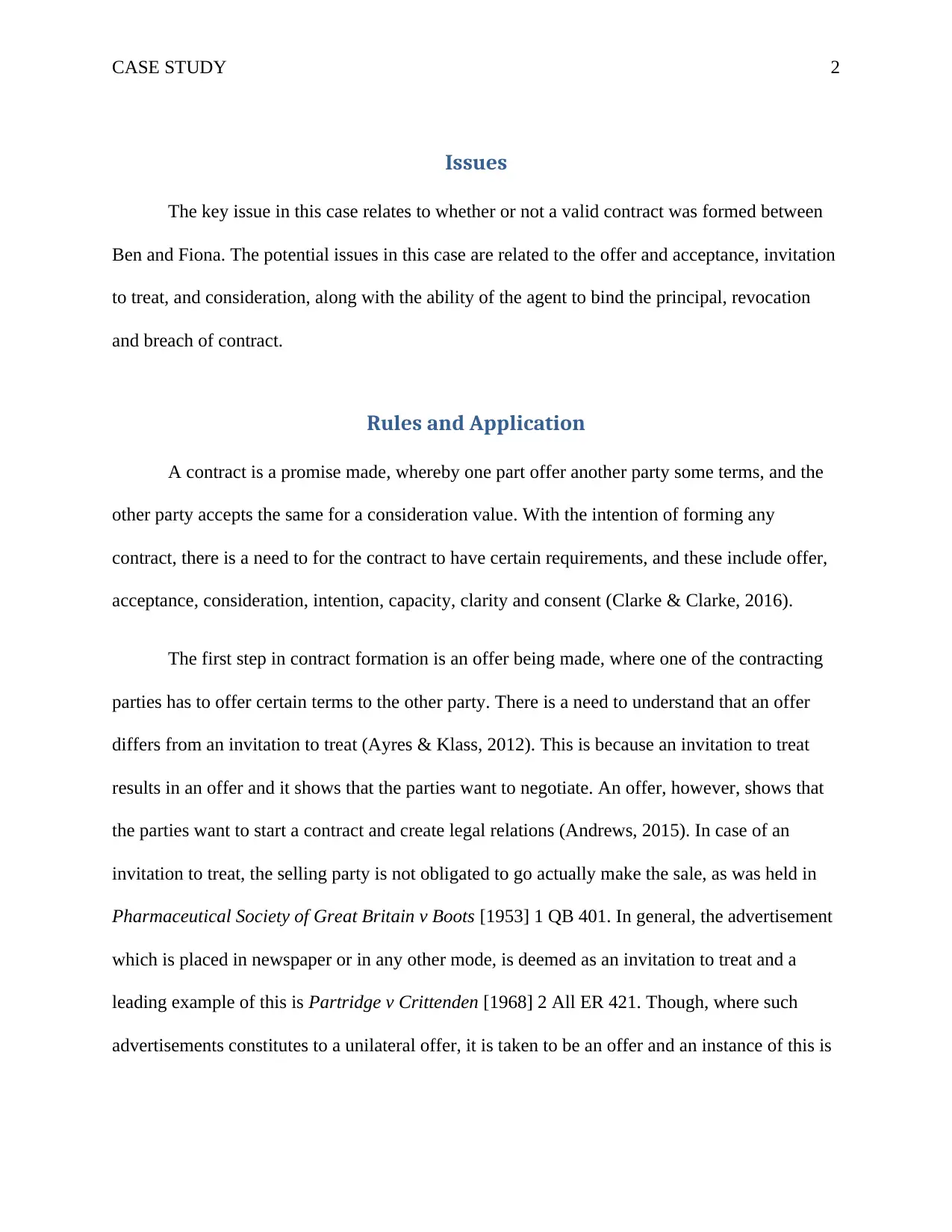
CASE STUDY 2
Issues
The key issue in this case relates to whether or not a valid contract was formed between
Ben and Fiona. The potential issues in this case are related to the offer and acceptance, invitation
to treat, and consideration, along with the ability of the agent to bind the principal, revocation
and breach of contract.
Rules and Application
A contract is a promise made, whereby one part offer another party some terms, and the
other party accepts the same for a consideration value. With the intention of forming any
contract, there is a need to for the contract to have certain requirements, and these include offer,
acceptance, consideration, intention, capacity, clarity and consent (Clarke & Clarke, 2016).
The first step in contract formation is an offer being made, where one of the contracting
parties has to offer certain terms to the other party. There is a need to understand that an offer
differs from an invitation to treat (Ayres & Klass, 2012). This is because an invitation to treat
results in an offer and it shows that the parties want to negotiate. An offer, however, shows that
the parties want to start a contract and create legal relations (Andrews, 2015). In case of an
invitation to treat, the selling party is not obligated to go actually make the sale, as was held in
Pharmaceutical Society of Great Britain v Boots [1953] 1 QB 401. In general, the advertisement
which is placed in newspaper or in any other mode, is deemed as an invitation to treat and a
leading example of this is Partridge v Crittenden [1968] 2 All ER 421. Though, where such
advertisements constitutes to a unilateral offer, it is taken to be an offer and an instance of this is
Issues
The key issue in this case relates to whether or not a valid contract was formed between
Ben and Fiona. The potential issues in this case are related to the offer and acceptance, invitation
to treat, and consideration, along with the ability of the agent to bind the principal, revocation
and breach of contract.
Rules and Application
A contract is a promise made, whereby one part offer another party some terms, and the
other party accepts the same for a consideration value. With the intention of forming any
contract, there is a need to for the contract to have certain requirements, and these include offer,
acceptance, consideration, intention, capacity, clarity and consent (Clarke & Clarke, 2016).
The first step in contract formation is an offer being made, where one of the contracting
parties has to offer certain terms to the other party. There is a need to understand that an offer
differs from an invitation to treat (Ayres & Klass, 2012). This is because an invitation to treat
results in an offer and it shows that the parties want to negotiate. An offer, however, shows that
the parties want to start a contract and create legal relations (Andrews, 2015). In case of an
invitation to treat, the selling party is not obligated to go actually make the sale, as was held in
Pharmaceutical Society of Great Britain v Boots [1953] 1 QB 401. In general, the advertisement
which is placed in newspaper or in any other mode, is deemed as an invitation to treat and a
leading example of this is Partridge v Crittenden [1968] 2 All ER 421. Though, where such
advertisements constitutes to a unilateral offer, it is taken to be an offer and an instance of this is
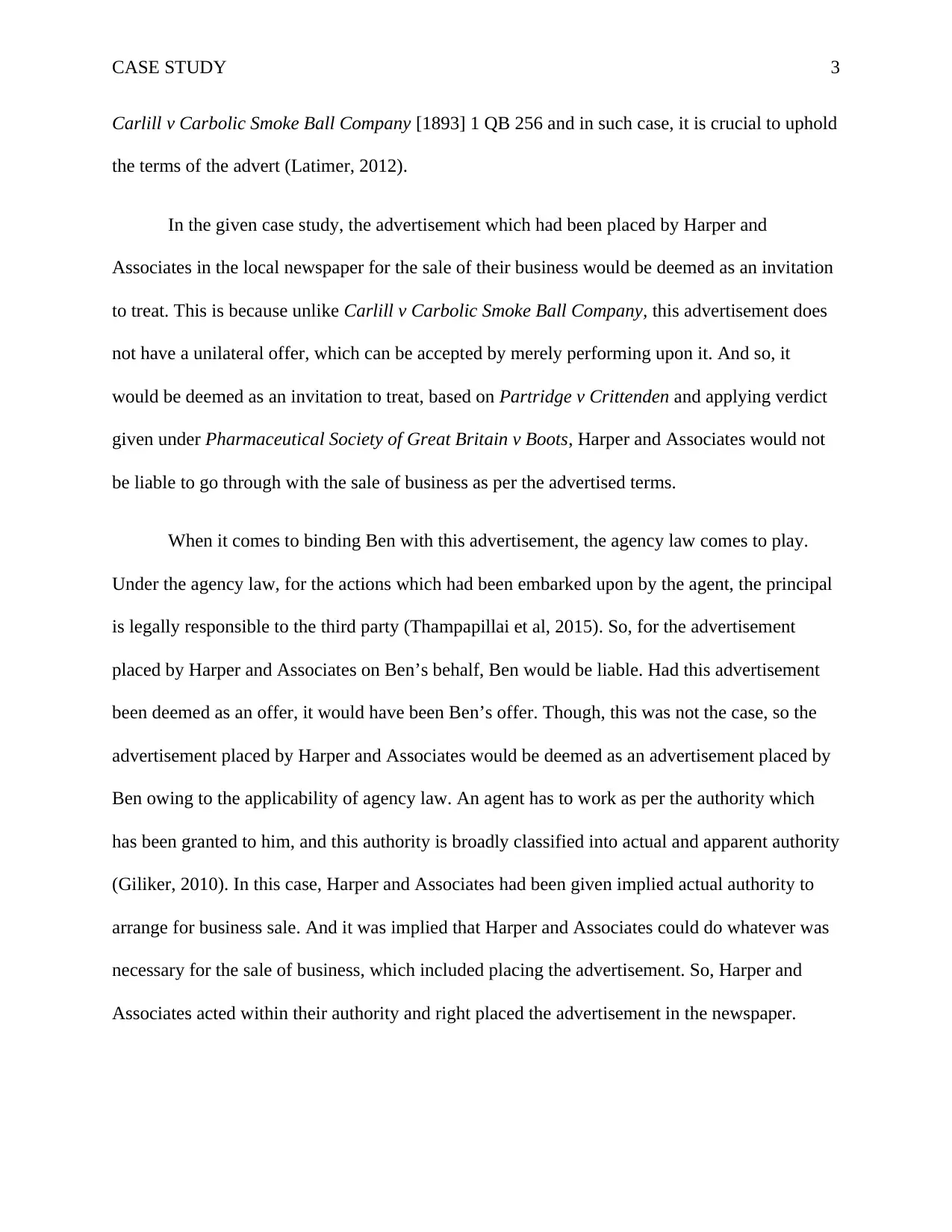
CASE STUDY 3
Carlill v Carbolic Smoke Ball Company [1893] 1 QB 256 and in such case, it is crucial to uphold
the terms of the advert (Latimer, 2012).
In the given case study, the advertisement which had been placed by Harper and
Associates in the local newspaper for the sale of their business would be deemed as an invitation
to treat. This is because unlike Carlill v Carbolic Smoke Ball Company, this advertisement does
not have a unilateral offer, which can be accepted by merely performing upon it. And so, it
would be deemed as an invitation to treat, based on Partridge v Crittenden and applying verdict
given under Pharmaceutical Society of Great Britain v Boots, Harper and Associates would not
be liable to go through with the sale of business as per the advertised terms.
When it comes to binding Ben with this advertisement, the agency law comes to play.
Under the agency law, for the actions which had been embarked upon by the agent, the principal
is legally responsible to the third party (Thampapillai et al, 2015). So, for the advertisement
placed by Harper and Associates on Ben’s behalf, Ben would be liable. Had this advertisement
been deemed as an offer, it would have been Ben’s offer. Though, this was not the case, so the
advertisement placed by Harper and Associates would be deemed as an advertisement placed by
Ben owing to the applicability of agency law. An agent has to work as per the authority which
has been granted to him, and this authority is broadly classified into actual and apparent authority
(Giliker, 2010). In this case, Harper and Associates had been given implied actual authority to
arrange for business sale. And it was implied that Harper and Associates could do whatever was
necessary for the sale of business, which included placing the advertisement. So, Harper and
Associates acted within their authority and right placed the advertisement in the newspaper.
Carlill v Carbolic Smoke Ball Company [1893] 1 QB 256 and in such case, it is crucial to uphold
the terms of the advert (Latimer, 2012).
In the given case study, the advertisement which had been placed by Harper and
Associates in the local newspaper for the sale of their business would be deemed as an invitation
to treat. This is because unlike Carlill v Carbolic Smoke Ball Company, this advertisement does
not have a unilateral offer, which can be accepted by merely performing upon it. And so, it
would be deemed as an invitation to treat, based on Partridge v Crittenden and applying verdict
given under Pharmaceutical Society of Great Britain v Boots, Harper and Associates would not
be liable to go through with the sale of business as per the advertised terms.
When it comes to binding Ben with this advertisement, the agency law comes to play.
Under the agency law, for the actions which had been embarked upon by the agent, the principal
is legally responsible to the third party (Thampapillai et al, 2015). So, for the advertisement
placed by Harper and Associates on Ben’s behalf, Ben would be liable. Had this advertisement
been deemed as an offer, it would have been Ben’s offer. Though, this was not the case, so the
advertisement placed by Harper and Associates would be deemed as an advertisement placed by
Ben owing to the applicability of agency law. An agent has to work as per the authority which
has been granted to him, and this authority is broadly classified into actual and apparent authority
(Giliker, 2010). In this case, Harper and Associates had been given implied actual authority to
arrange for business sale. And it was implied that Harper and Associates could do whatever was
necessary for the sale of business, which included placing the advertisement. So, Harper and
Associates acted within their authority and right placed the advertisement in the newspaper.

CASE STUDY 4
For the actions of an agent, the principal is legally responsible towards the third party.
And an agent owes definite responsibilitis to the principal which includes working with the
authority which has been given to the agent. However, the principal is not liable to follow the
directions or decisions made by the agent, even though it is preferable to do so, or else the
purpose of giving authority to the agent is breached. Hence, Ben had the authority to make an
offer to another party, without having to consult Harper and Associates and without having to
follow the advertisement. This is also because of the fact that the requirement of not selling
below $300,000 was contained in an invitation to treat and not in an offer. Hence, this is not a
term of the contract which needs to be followed. So, Ben could right sell the business for a price
lower than the advertised price.
The next step in the formation of contract is acceptance of the offer which had been
made. It is important that the offer is accepted by the party to which the offer was made
(Lambiris & Griffin, 2016). Also, it is important that the acceptance is given to the offer in the
very same way in which it had been earlier made. It is important that the acceptance is properly
communicated and the date on which the acceptance message gets to the offering party, is to be
taken for the purpose of date of acceptance (Stone & Devenney, 2017). In case any term is
changed, which was made in the offer, when the acceptance is being sent, it results in a counter
offer and a leading example of this is Hyde v. Wrench (1840) 3 Beav 334 case (Marson & Ferris,
2015). A key point pertaining to acceptance is the date of acceptance on which the exception is
of postal rules. As per the postal rules, the “date of acceptance” is the “date on which the
acceptance” is sent by the sender, due to the acceptance being sent through post, and the postal
office being deemed as the agent of the offering party (Latimer, 2012). The postal rules are
For the actions of an agent, the principal is legally responsible towards the third party.
And an agent owes definite responsibilitis to the principal which includes working with the
authority which has been given to the agent. However, the principal is not liable to follow the
directions or decisions made by the agent, even though it is preferable to do so, or else the
purpose of giving authority to the agent is breached. Hence, Ben had the authority to make an
offer to another party, without having to consult Harper and Associates and without having to
follow the advertisement. This is also because of the fact that the requirement of not selling
below $300,000 was contained in an invitation to treat and not in an offer. Hence, this is not a
term of the contract which needs to be followed. So, Ben could right sell the business for a price
lower than the advertised price.
The next step in the formation of contract is acceptance of the offer which had been
made. It is important that the offer is accepted by the party to which the offer was made
(Lambiris & Griffin, 2016). Also, it is important that the acceptance is given to the offer in the
very same way in which it had been earlier made. It is important that the acceptance is properly
communicated and the date on which the acceptance message gets to the offering party, is to be
taken for the purpose of date of acceptance (Stone & Devenney, 2017). In case any term is
changed, which was made in the offer, when the acceptance is being sent, it results in a counter
offer and a leading example of this is Hyde v. Wrench (1840) 3 Beav 334 case (Marson & Ferris,
2015). A key point pertaining to acceptance is the date of acceptance on which the exception is
of postal rules. As per the postal rules, the “date of acceptance” is the “date on which the
acceptance” is sent by the sender, due to the acceptance being sent through post, and the postal
office being deemed as the agent of the offering party (Latimer, 2012). The postal rules are
Secure Best Marks with AI Grader
Need help grading? Try our AI Grader for instant feedback on your assignments.
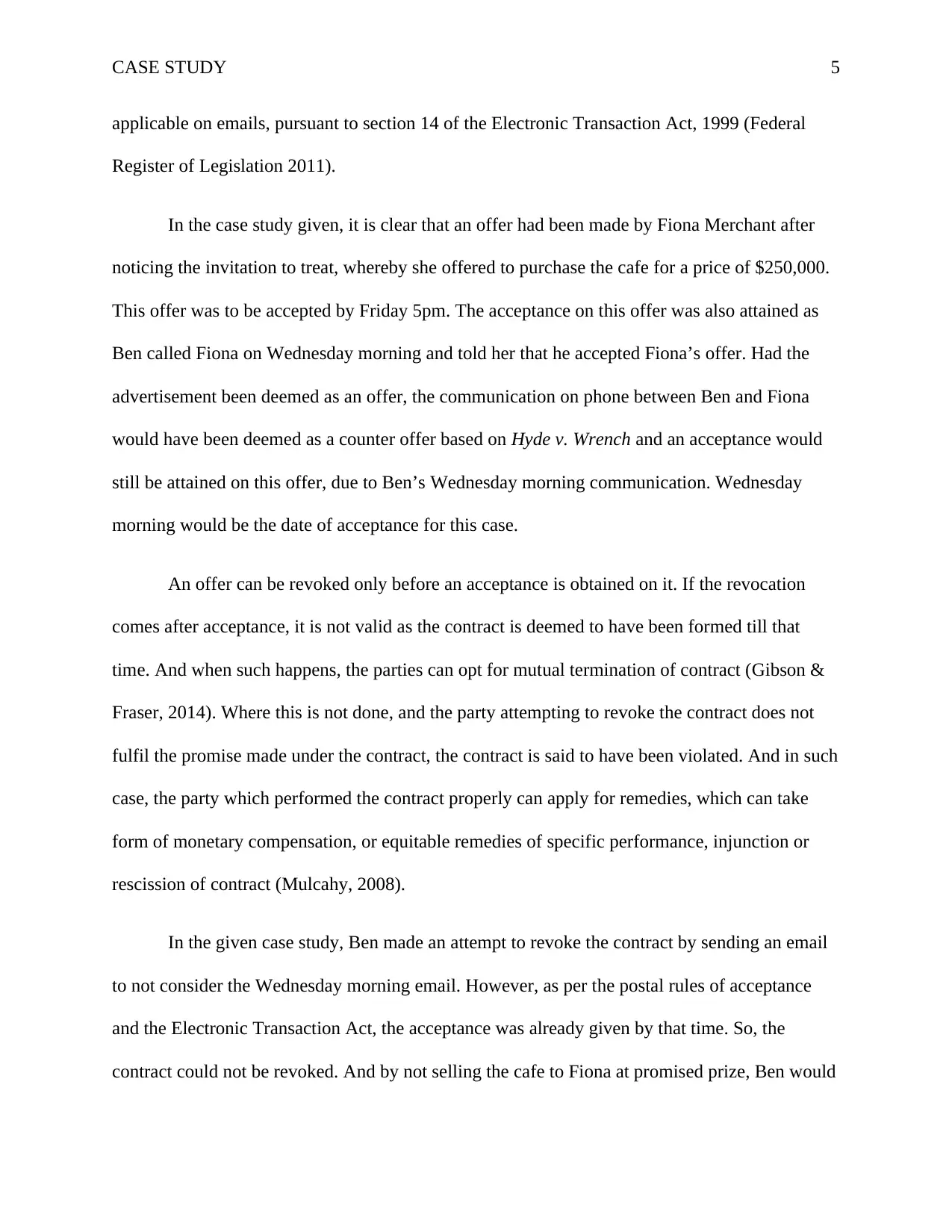
CASE STUDY 5
applicable on emails, pursuant to section 14 of the Electronic Transaction Act, 1999 (Federal
Register of Legislation 2011).
In the case study given, it is clear that an offer had been made by Fiona Merchant after
noticing the invitation to treat, whereby she offered to purchase the cafe for a price of $250,000.
This offer was to be accepted by Friday 5pm. The acceptance on this offer was also attained as
Ben called Fiona on Wednesday morning and told her that he accepted Fiona’s offer. Had the
advertisement been deemed as an offer, the communication on phone between Ben and Fiona
would have been deemed as a counter offer based on Hyde v. Wrench and an acceptance would
still be attained on this offer, due to Ben’s Wednesday morning communication. Wednesday
morning would be the date of acceptance for this case.
An offer can be revoked only before an acceptance is obtained on it. If the revocation
comes after acceptance, it is not valid as the contract is deemed to have been formed till that
time. And when such happens, the parties can opt for mutual termination of contract (Gibson &
Fraser, 2014). Where this is not done, and the party attempting to revoke the contract does not
fulfil the promise made under the contract, the contract is said to have been violated. And in such
case, the party which performed the contract properly can apply for remedies, which can take
form of monetary compensation, or equitable remedies of specific performance, injunction or
rescission of contract (Mulcahy, 2008).
In the given case study, Ben made an attempt to revoke the contract by sending an email
to not consider the Wednesday morning email. However, as per the postal rules of acceptance
and the Electronic Transaction Act, the acceptance was already given by that time. So, the
contract could not be revoked. And by not selling the cafe to Fiona at promised prize, Ben would
applicable on emails, pursuant to section 14 of the Electronic Transaction Act, 1999 (Federal
Register of Legislation 2011).
In the case study given, it is clear that an offer had been made by Fiona Merchant after
noticing the invitation to treat, whereby she offered to purchase the cafe for a price of $250,000.
This offer was to be accepted by Friday 5pm. The acceptance on this offer was also attained as
Ben called Fiona on Wednesday morning and told her that he accepted Fiona’s offer. Had the
advertisement been deemed as an offer, the communication on phone between Ben and Fiona
would have been deemed as a counter offer based on Hyde v. Wrench and an acceptance would
still be attained on this offer, due to Ben’s Wednesday morning communication. Wednesday
morning would be the date of acceptance for this case.
An offer can be revoked only before an acceptance is obtained on it. If the revocation
comes after acceptance, it is not valid as the contract is deemed to have been formed till that
time. And when such happens, the parties can opt for mutual termination of contract (Gibson &
Fraser, 2014). Where this is not done, and the party attempting to revoke the contract does not
fulfil the promise made under the contract, the contract is said to have been violated. And in such
case, the party which performed the contract properly can apply for remedies, which can take
form of monetary compensation, or equitable remedies of specific performance, injunction or
rescission of contract (Mulcahy, 2008).
In the given case study, Ben made an attempt to revoke the contract by sending an email
to not consider the Wednesday morning email. However, as per the postal rules of acceptance
and the Electronic Transaction Act, the acceptance was already given by that time. So, the
contract could not be revoked. And by not selling the cafe to Fiona at promised prize, Ben would
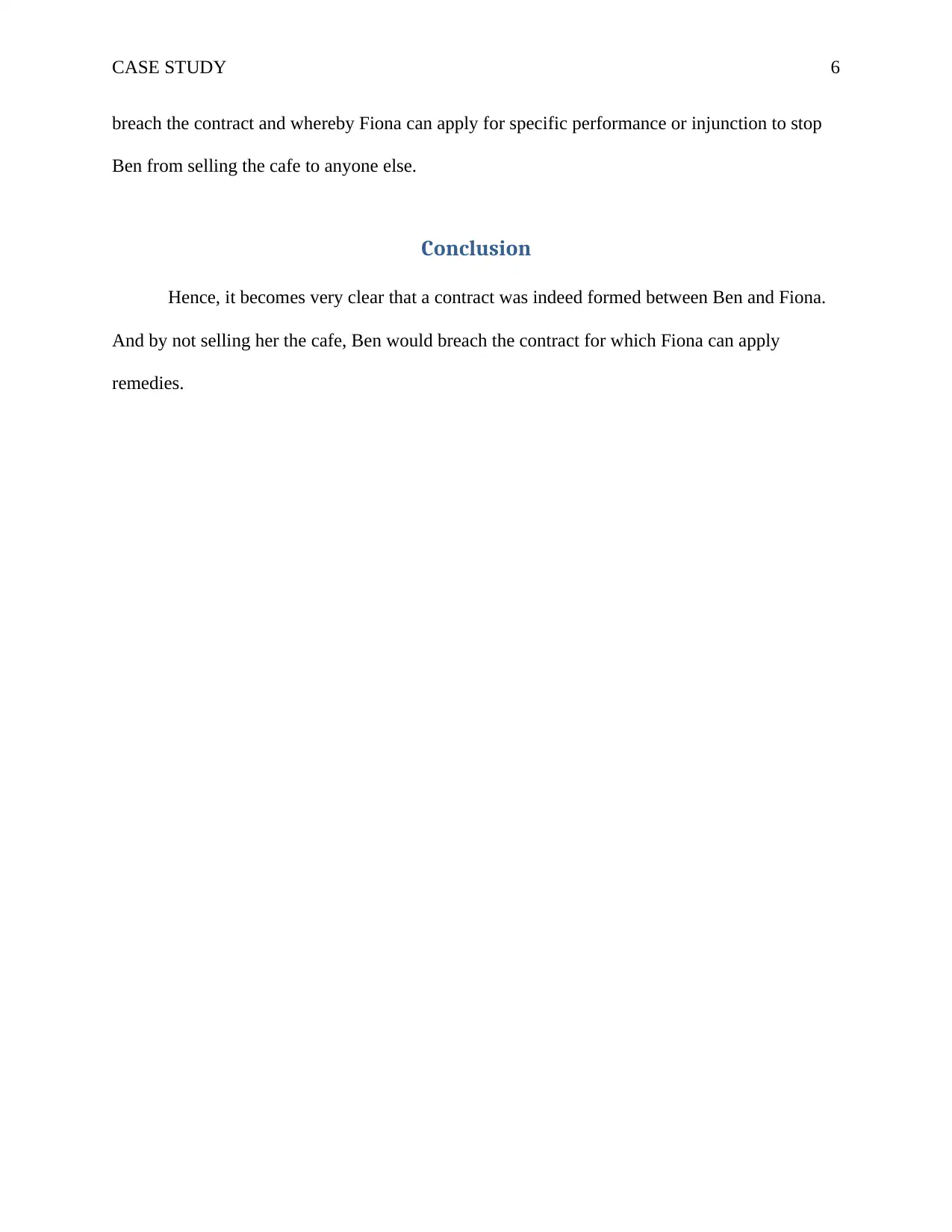
CASE STUDY 6
breach the contract and whereby Fiona can apply for specific performance or injunction to stop
Ben from selling the cafe to anyone else.
Conclusion
Hence, it becomes very clear that a contract was indeed formed between Ben and Fiona.
And by not selling her the cafe, Ben would breach the contract for which Fiona can apply
remedies.
breach the contract and whereby Fiona can apply for specific performance or injunction to stop
Ben from selling the cafe to anyone else.
Conclusion
Hence, it becomes very clear that a contract was indeed formed between Ben and Fiona.
And by not selling her the cafe, Ben would breach the contract for which Fiona can apply
remedies.
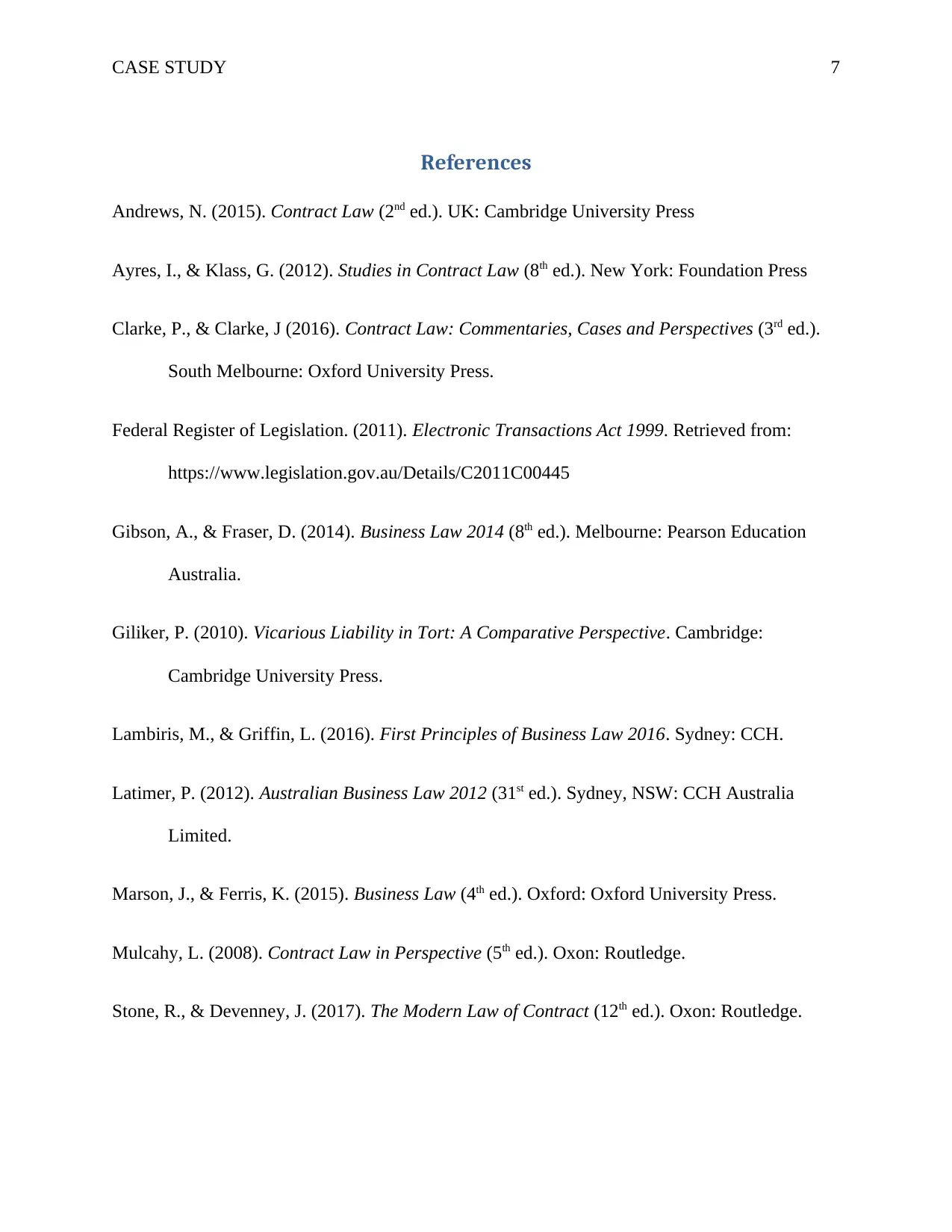
CASE STUDY 7
References
Andrews, N. (2015). Contract Law (2nd ed.). UK: Cambridge University Press
Ayres, I., & Klass, G. (2012). Studies in Contract Law (8th ed.). New York: Foundation Press
Clarke, P., & Clarke, J (2016). Contract Law: Commentaries, Cases and Perspectives (3rd ed.).
South Melbourne: Oxford University Press.
Federal Register of Legislation. (2011). Electronic Transactions Act 1999. Retrieved from:
https://www.legislation.gov.au/Details/C2011C00445
Gibson, A., & Fraser, D. (2014). Business Law 2014 (8th ed.). Melbourne: Pearson Education
Australia.
Giliker, P. (2010). Vicarious Liability in Tort: A Comparative Perspective. Cambridge:
Cambridge University Press.
Lambiris, M., & Griffin, L. (2016). First Principles of Business Law 2016. Sydney: CCH.
Latimer, P. (2012). Australian Business Law 2012 (31st ed.). Sydney, NSW: CCH Australia
Limited.
Marson, J., & Ferris, K. (2015). Business Law (4th ed.). Oxford: Oxford University Press.
Mulcahy, L. (2008). Contract Law in Perspective (5th ed.). Oxon: Routledge.
Stone, R., & Devenney, J. (2017). The Modern Law of Contract (12th ed.). Oxon: Routledge.
References
Andrews, N. (2015). Contract Law (2nd ed.). UK: Cambridge University Press
Ayres, I., & Klass, G. (2012). Studies in Contract Law (8th ed.). New York: Foundation Press
Clarke, P., & Clarke, J (2016). Contract Law: Commentaries, Cases and Perspectives (3rd ed.).
South Melbourne: Oxford University Press.
Federal Register of Legislation. (2011). Electronic Transactions Act 1999. Retrieved from:
https://www.legislation.gov.au/Details/C2011C00445
Gibson, A., & Fraser, D. (2014). Business Law 2014 (8th ed.). Melbourne: Pearson Education
Australia.
Giliker, P. (2010). Vicarious Liability in Tort: A Comparative Perspective. Cambridge:
Cambridge University Press.
Lambiris, M., & Griffin, L. (2016). First Principles of Business Law 2016. Sydney: CCH.
Latimer, P. (2012). Australian Business Law 2012 (31st ed.). Sydney, NSW: CCH Australia
Limited.
Marson, J., & Ferris, K. (2015). Business Law (4th ed.). Oxford: Oxford University Press.
Mulcahy, L. (2008). Contract Law in Perspective (5th ed.). Oxon: Routledge.
Stone, R., & Devenney, J. (2017). The Modern Law of Contract (12th ed.). Oxon: Routledge.
Paraphrase This Document
Need a fresh take? Get an instant paraphrase of this document with our AI Paraphraser
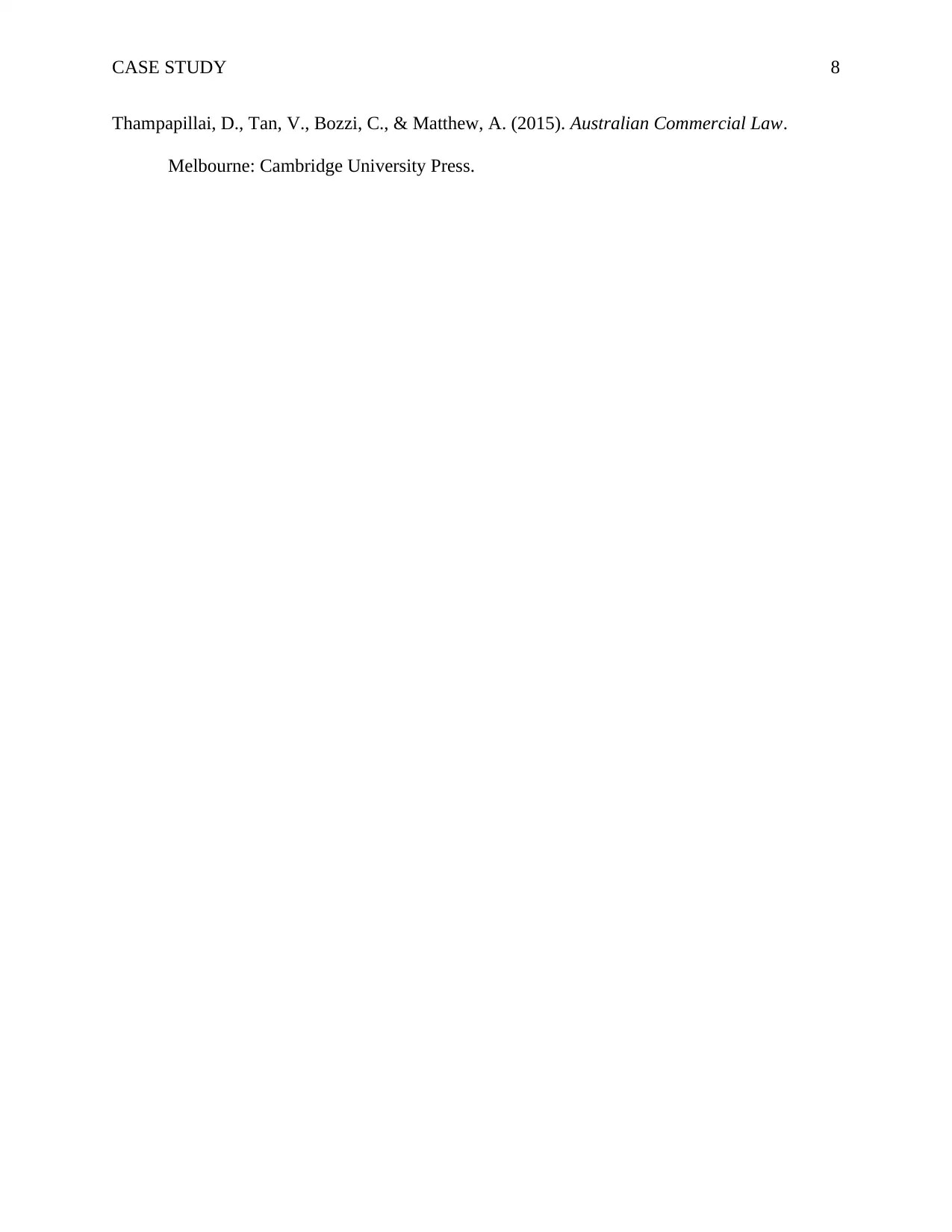
CASE STUDY 8
Thampapillai, D., Tan, V., Bozzi, C., & Matthew, A. (2015). Australian Commercial Law.
Melbourne: Cambridge University Press.
Thampapillai, D., Tan, V., Bozzi, C., & Matthew, A. (2015). Australian Commercial Law.
Melbourne: Cambridge University Press.
1 out of 8
Related Documents
Your All-in-One AI-Powered Toolkit for Academic Success.
+13062052269
info@desklib.com
Available 24*7 on WhatsApp / Email
![[object Object]](/_next/static/media/star-bottom.7253800d.svg)
Unlock your academic potential
© 2024 | Zucol Services PVT LTD | All rights reserved.




